Related Research Articles
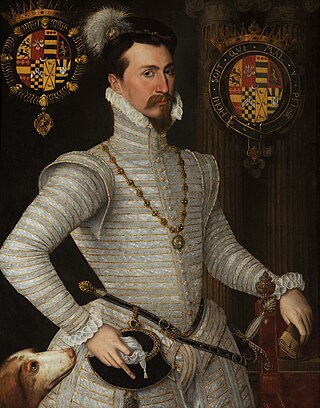
Robert Dudley, 1st Earl of Leicester, was an English statesman and the favourite of Elizabeth I from her accession until his death. He was a suitor for the queen's hand for many years.

The masque was a form of festive courtly entertainment that flourished in 16th- and early 17th-century Europe, though it was developed earlier in Italy, in forms including the intermedio. A masque involved music, dancing, singing and acting, within an elaborate stage design, in which the architectural framing and costumes might be designed by a renowned architect, to present a deferential allegory flattering to the patron. Professional actors and musicians were hired for the speaking and singing parts. Masquers who did not speak or sing were often courtiers: the English queen Anne of Denmark frequently danced with her ladies in masques between 1603 and 1611, and Henry VIII and Charles I of England performed in the masques at their courts. In the tradition of masque, Louis XIV of France danced in ballets at Versailles with music by Jean-Baptiste Lully.

Sir Philip Sidney was an English poet, courtier, scholar and soldier who is remembered as one of the most prominent figures of the Elizabethan age.
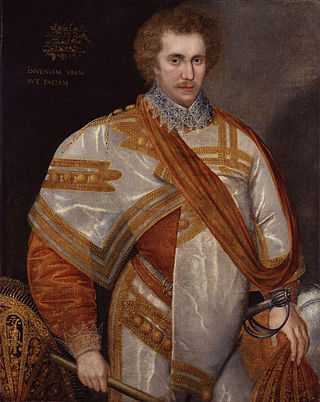
Robert Sidney, 1st Earl of Leicester, was an English courtier, soldier, and landowner. He was chamberlain to Anne of Denmark.
Sir Edward Dyer was an English courtier and poet.
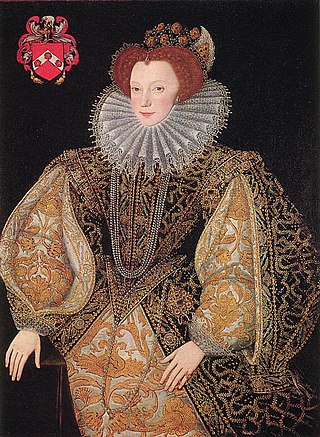
Lettice Knollys, Countess of Essex and Countess of Leicester, was an English noblewoman and mother to the courtiers Robert Devereux, 2nd Earl of Essex, and Lady Penelope Rich. By her second marriage to Elizabeth I's favourite, Robert Dudley, Earl of Leicester, she incurred the Queen's unrelenting displeasure.
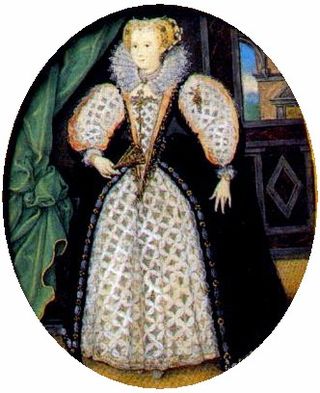
Penelope Rich, Lady Rich, later styled Penelope Blount was an English court office holder. She served as lady-in-waiting to the English queen Anne of Denmark. She was the sister of Robert Devereux, 2nd Earl of Essex, and is traditionally thought to be the inspiration for "Stella" of Sir Philip Sidney's Astrophel and Stella sonnet sequence. She was married to Robert Rich, 3rd Baron Rich and had a public liaison with Charles Blount, Baron Mountjoy, whom she married in an unlicensed ceremony following her divorce from Rich. She died in 1607.

Lady Mary Wroth was an English noblewoman and a poet of the English Renaissance. A member of a distinguished literary family, Lady Wroth was among the first female English writers to have achieved an enduring reputation. Mary Wroth was niece to Mary Herbert née Sidney, and to Sir Philip Sidney, a famous Elizabethan poet-courtier.
Elizabeth, Lady Coke, was an English court office holder. She served as lady-in-waiting to the queen consort of England, Anne of Denmark. She was the daughter of Thomas Cecil, 1st Earl of Exeter, and Dorothy Neville, and the granddaughter of William Cecil, 1st Baron Burghley. She was the wife of Sir William Hatton and later of Sir Edward Coke.
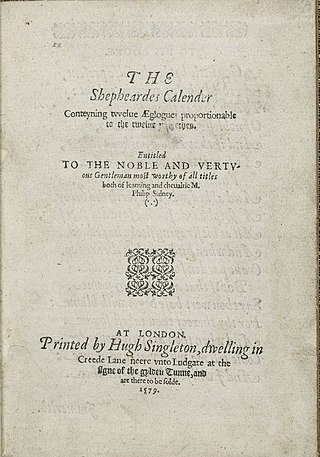
The Shepheardes Calender was Edmund Spenser's first major poetic work, published in 1579. In emulation of Virgil's first work, the Eclogues, Spenser wrote this series of pastorals at the commencement of his career. However, Spenser's models were rather the Renaissance eclogues of Mantuanus. The title, like the entire work, is written using deliberately archaic spellings, in order to suggest a connection to medieval literature, and to Geoffrey Chaucer in particular. Spenser dedicated the poem to Philip Sidney. The poem introduces Colin Clout, a folk character originated by John Skelton, and depicts his life as a shepherd through the twelve months of the year. The Calender encompasses considerable formal innovations, anticipating the even more virtuosic Countess of Pembroke's Arcadia, the classic pastoral romance by Sir Philip Sidney, with whom Spenser was acquainted. It is also remarkable for the extensive commentary or gloss included with the work in its first publication, ascribed to an "E.K." E.K. is an intelligent, very subtle, sometimes wrong, and often deeply ironic commentator, who is sometimes assumed to be an alias of Spenser himself. The term sarcasm (Sarcasmus) is first recorded in English in Spenser's poem (October).

The Masque of Blackness was an early Jacobean era masque, first performed at the Stuart Court in the Banqueting Hall of Whitehall Palace on Twelfth Night, 6 January 1605. It was written by Ben Jonson at the request of Anne of Denmark, the queen consort of King James I, who wished the masquers to be disguised as Africans. Anne was one of the performers in the masque along with her court ladies, all of whom appeared in blackface makeup. In a ceremony earlier on the day, Prince Charles, Anne's second son was given the title of Duke of York.

Barbara Sidney, Countess of Leicester was a Welsh heiress, and the first wife of Robert Sidney, 1st Earl of Leicester. Her family connections tied her to prominent contemporary figures such as Sir Walter Raleigh.
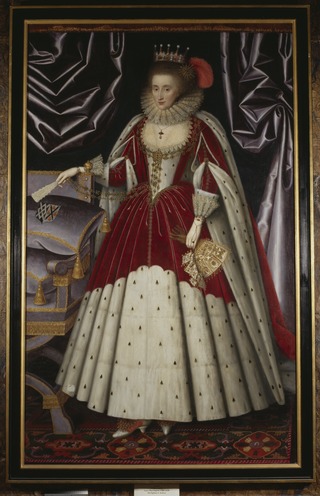
Lucy Russell, Countess of Bedford was a major aristocratic patron of the arts and literature in the Elizabethan and Jacobean eras, the primary non-royal performer in contemporary court masques, a letter-writer, and a poet. She was an adventurer (shareholder) in the Somers Isles Company, investing in Bermuda, where Harrington Sound is named after her.

The Hue and Cry After Cupid, or A Hue and Cry After Cupid, also Lord Haddington's Masque or The Masque at Lord Haddington's Marriage, or even The Masque With the Nuptial Songs at the Lord Viscount Haddington's Marriage at Court, was a masque performed on Shrove Tuesday night, 9 February 1608, in the Banqueting House at Whitehall Palace. The work was written by Ben Jonson, with costumes, sets, and stage effects designed by Inigo Jones, and with music by Alfonso Ferrabosco – the team of creators responsible for previous and subsequent masques for the Stuart Court.

Frances Radclyffe, Countess of Sussex was a Lady of the Bedchamber to Queen Elizabeth I and the founder of Sidney Sussex College, Cambridge. She was the daughter of Sir William Sidney, of Penshurst Place in Kent, a prominent courtier during the reign of King Henry VIII, and his wife, the former Anne Packenham. She was the sister of Sir Henry Sidney, and aunt to both the poet Sir Philip Sidney and the first Sidney Earl of Leicester.

Lady Mary Sidney was a lady-in-waiting at the court of Elizabeth I, wife of Sir Henry Sidney and the mother of Sir Philip Sidney and Mary Sidney Herbert, Countess of Pembroke. She was daughter of John Dudley, Duke of Northumberland, and sister of Elizabeth's favourite, Robert Dudley, Earl of Leicester.
Lady Audrey Walsingham was an English courtier. She served as Lady of the Bedchamber to queen Elizabeth I of England, and then as Mistress of the Robes to Anne of Denmark from 1603 until 1619.
Elizabeth Howard, Lady Knollys, was a courtier to Anne of Denmark.

Elizabeth Southwell (1584–1631) was an English courtier who lived in Florence.
Honora Denny was an English courtier.
References
- ↑ University of Oregon's etext and analysis
- ↑ Cooper, H. (2004). Pastoral: Mediaeval into Renaissance. D.S. Brewer
- ↑ 'Poetry, patronage and the court' in The Cambridge Companion to English Literature, 1500-1600